
Firearms Owners Against Crime
Institute for Legal, Legislative and Educational Action

Institute for Legal, Legislative and Educational Action
By now we all know about ATF’s proposed “Objective Factors” document by which the agency intends to determine the classification — pistol or short barreled rifle — of a stabilizer brace-equipped pistol. Also by now I hope we have all left a public comment as well as contacted the White House and our representatives to make our opinions heard.
With that done, let’s take a deep dive into each “objective factor” listed in ATF’s draft guidance document to see how they hold up under scrutiny. I think we’ll find that, rather than being “objective,” each factor is objectively subjective. They are so vague, in fact, that it provides the opposite of any sort of guidance and assures nothing but fear, uncertainty, and doubt among the firearm industry and consumers and effectively gives ATF carte blanche to enforce “violations” however it chooses.
Perhaps worse, or at least most insulting, much of the alleged guidance found in the document contradicts ATF’s own rulings and practices, past and current.
While I can’t envision much of any of this holding up in court — ATF’s track record on pistol brace-related prosecutions thus far is 0-1 — none of us wants or can afford to be the test case. Should it comes to pass, though, here are some arguments refuting each and every one of ATF’s proposed determining factors for brace-equipped firearm classification.
All quotes below unless otherwise cited are directly from ATF’s draft “Objective Factors for Classifying Weapons with Stabilizing Braces” document. Any emphasis in said quotes (bold lettering) was added by me:
The GCA and NFA generally regulate “firearms” and not individual components and, as such, ATF does not classify unregulated components or accessories alone.
This is an intentionally misleading statement. ATF has classified all sorts of components and accessories on their own (as it must), such as trigger cranks, binary triggers, lightning links, bump stocks, muzzle devices, forward grips, the Auto Glove, naughty rubber bands, naughty shoe strings, naughty coat hangers, solvent traps, 80% receiver kits, thread adapters, and so much more.
If ATF didn’t classify accessories, then how does it explain its public notice from December, 2018 in which it informed the nation of its brand new change in policy whereby it would, effective on that very date, no longer classify an accessory unless it is installed on a complete firearm?
Furthermore, how is this practical or in any way tenable? Is ATF seriously suggesting that f I want it to make a determination on the use of an angled forward grip on a pistol (by way of one example for which ATF ruled in a categorical fashion in the past) I have to submit it installed on a specific firearm and their ruling will only apply to that one, specific model and its complete, specific configuration to include choice of optics and literally everything else?
This is impossible and it makes no sense.
The ATF must make determinations on firearms and on accessories. This is the only way the industry and the consumer can know whether or not they are following the law. “This firearm is a pistol,” and “this accessory does not change the classification of a pistol.” Boom, done.
Accordingly, ATF must evaluate whether a particular firearm configured with a stabilizing brace bears the objective features of a firearm designed and intended to be fired from the shoulder, and thus subject to the NFA, on a case-by-case basis.
An “each one of you has to show us your complete configuration and then we’ll determine if you’re a felon or not based on vaguely-defined guidelines” is not how things work in the United States of America.
In fact, the United States Constitution holds that vagueness in the law is a violation of due process.
Likewise, the rule of strict construction holds that U.S. courts must hold in the favor of the defendant and against the government in any case involving unclear or ambiguous law.
…the purpose of the NFA is “to regulate certain weapons likely to be used for criminal purposes,” United States v. Thompson/Center Arms Co., 504 U.S. 505, 517 (1992)…
T/C won that case in front of the Supreme Court, by the way. Playing a big part in T/C’s win was the rule of strict construction mentioned above.
Anyway, all known data proves beyond any shadow of a doubt that stabilizing brace-equipped pistols are not likely to be used for criminal purposes. With at least six million of them in private hands, there has been one (1) known criminal act committed with such a firearm over the last eight or more years.
Furthermore, if ATF’s assertion is that some portion of brace-equipped firearms are actually SBRs — short barreled rifles — we have even more data that show SBRs are not likely to be used for criminal purposes. State and federal crime data for decades has show that rifles of all types are used in approximately three percent of murders and that about 1.3% of armed criminals are armed with any sort of rifle.
Short barreled rifles, being a tiny little fraction of the “rifles” category (yet legally owned by well over 400,000 Americans and only a hacksaw away from use by any criminal), are patently not likely to be used for criminal purposes and the data very clearly bear this out.
For those who like to point to other countries as enlightened examples of what the U.S. should do or consider, allow me to note that we are the only country in the world — despite the vast majority of other “Western” countries having stricter gun control laws — to regulate rifles based on barrel length. The 1934 NFA law that created these restrictions is antiquated, irrelevant, and proven to be unnecessary.
Instead of adding braced pistols to the NFA, we should remove SBRs from it. It’s possible, too. This time last year H.R. 5289, which would have done just that, was introduced in the House. That bill was referred to multiple committees, and received 25 co-sponsors.
Let’s keep pushing. This is the permanent solution to ATF’s continued rogue actions to undermine the firearm industry, gun ownership, and the Second Amendment writ large.
Type and Caliber. The type and caliber of the firearm to which the stabilizing brace or similar item is installed. A large caliber firearm that is impractical to fire with one hand because of recoil or other factors, even with an arm brace, is likely to be considered a rifle or shotgun.
Um . . . what? Get out of here with your “impractical” “large caliber” noise. I’ll determine what’s practical for me to fire, thank you very much. And I assure you it’s very different from what I determine is practical for my eight-year-old daughter to fire, which is different from what was practical when she was six.
Is the ATF seriously suggesting that this is an “objective factor?” What a farce. Does it believe that equal protection under the law could possibly apply should it attempt to prosecute a woman differently from a man, or a disabled person differently from a non-disabled person, based on what the ATF suggests is a “large caliber” or “impractical” for that person?
This is a perfect example of a vague and entirely undefined rule. “Objective” would be setting a ft-lbs of energy limit (e.g. a “pistol” may not fire a cartridge exceeding 1,000 ft-lbs of muzzle energy. To be clear I’d fight something like that tooth-and-nail, but that’s what an objective rule would look like). Intentionally vague, fear-inducing BS is the ATF’s proposed “objective factor” quoted above.
Regardless of whether it’s an objective factor or a vague, unconstitutional mess, I don’t recall anything about practicality appearing in the Second Amendment.
Is this a large caliber firearm that is impractical?
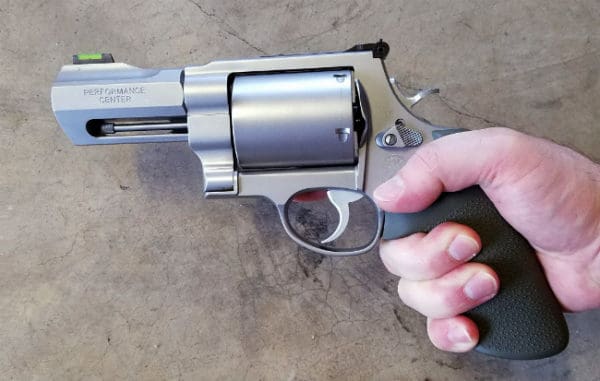
S&W X-Frame in .500 S&W Magnum
Or this?
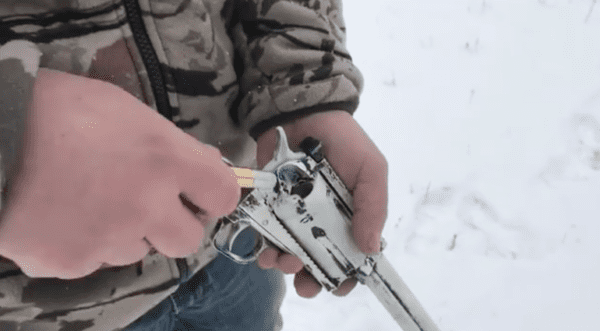
Magnum Research BFR in .45-70
Or this?
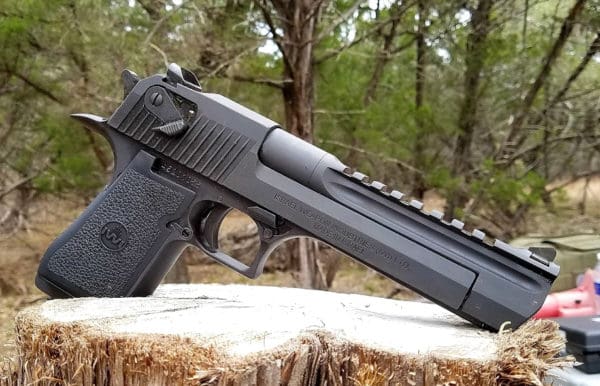
Desert Eagle in .50 AE
How about this?:
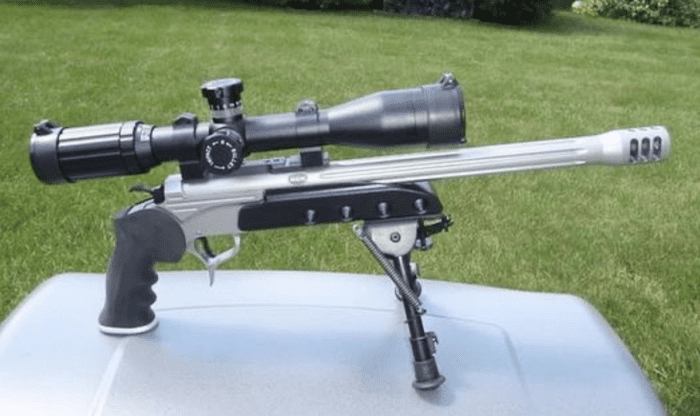
Thompson/Center, which could be chambered in literally any rifle cartridge ever made
Are these pistols now considered rifles because we can assume the ATF believes they fire a too-large caliber and/or are impractical to fire with one hand? No, no I didn’t think so.
Oh, it takes the installation of a stabilizing brace for ATF to consider these rifles? That makes no sense. Per ATF’s own admission in the bold text in the quote above and in the quote below, it fully understands that a pistol stabilizing brace assists in the safe, controllable use of a pistol precisely like the ones it claims are somehow acceptable to use without a brace but unacceptable to use with one:
In recent years, some manufacturers have produced and sold devices designed to be attached to large and/or heavy pistols which are marketed to help a shooter “stabilize” his or her arm to support single-handed fire (“braces”). ATF was advised by the first manufacturer to submit an arm brace for classification that the intent of the arm brace was to facilitate one-handed firing of the AR15 pistol for those with limited strength or mobility due to a handicap, and to reduce bruising to the forearm when firing with one hand. According to this manufacturer, the brace concept was inspired by the needs of disabled combat veterans who still enjoy recreational shooting but could not reliably control heavy pistols without assistance. Consequently, ATF agrees that there are legitimate uses for certain “stabilizing braces.”
ATF agrees that improving the shooter’s control of heavy pistols is a valid concern and was paramount to its original approval of the pistol stabilizing brace.
In the “Type and Caliber” quote above (above the photos of large handguns), ATF not only describes precisely the sort of firearm for which stabilizing braces make perhaps the most sense, it states as much in that very quote when it says “…even with an arm brace…”. This is tacit admission that arm braces improve the stability and control and, therefore, practicality of “large caliber” handguns.
Okay, onto the “objective factors” list now:
Weight and Length. The weight and length of the firearm used with the stabilizing brace. A firearm that is so heavy that it is impractical to fire or aim with one hand, or so long that it is difficult to balance the firearm to fire with one hand, is likely to be considered a rifle or shotgun.
First, ditto everything above. Everything I said related to type and caliber applies in identical fashion to weight and length.
But let’s now look at two aspects of federal law. First, what is a “pistol,” anyway?
Pistol. A weapon originally designed, made, and intended to fire a projectile (bullet) from one or more barrels when held in one hand, and having (a) a chamber(s) as an integral part(s) of, or permanently aligned with, the bore(s); and (b) a short stock designed to be gripped by one hand and at an angle to and extending below the line of the bore(s).
Revolvers, for the record, are later defined as a subset of the pistol category with a rotating, chambered cylinder.
The definition above is from the 1934 National Firearms Act. There have been some minor re-writings since (1968 Gun Control Act), but I quoted the NFA to point out that we have now defined pistols as guns designed to be fired when held in one hand for 86 years.
Aspect one: nowhere in the definition of “pistol” is any mention of weight or length. Sorry, but ATF does not get to invent restrictions in the law that do not exist. If I want to shoot a pistol with a one-meter-long barrel (and I have) I’m fully within my legal rights to do so, and for no reason whatsoever does it depart from the definition of “pistol.”
Aspect two: This is just stupid. No one teaches one-handed pistol shooting anymore (outside of competitions where one-handed shooting is part of the game or as a plan B due to injury or extreme proximity to one’s target). No one has since the 70’s.
Every law enforcement and military organization plus defensive and competitive shooters and trainers for all of these groups began phasing out the entire concept of operating handguns one-handed beginning in the late 50’s when the Weaver stance was developed.
Including the ATF:

RIP doggo

RIP doggo
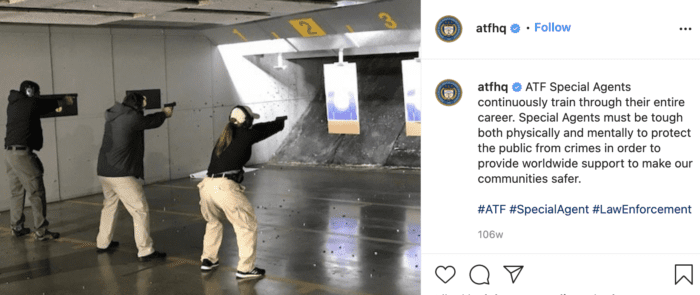
RIP doggo

RIP doggo
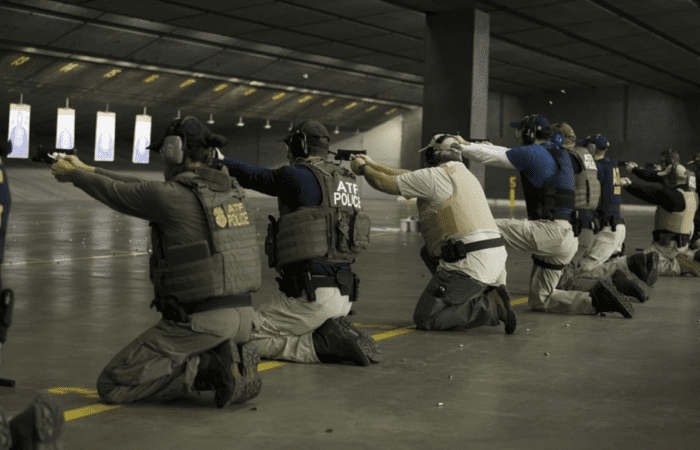
RIP doggo

RIP doggo
All photos above are from ATF’s Instagram feed. Incidentally, if you’re looking for a good time I highly recommend reading the comments on practically any photo whatsoever in the agency’s feed, but particularly any photo containing a dog or a fire.
Is ATF in violation of remanufacturing these pistols into SBRs because they were purchased with the clear intent of firing them with two hands? I think not. But since intent is apparently all that seems to matter to ATF, perhaps it should prosecute its agents and armorers.
At any rate, pretending to regulate handguns based on this entirely outdated definition is absurd on its face. Looking at precedent, ATF absolutely does not and has not regularly regulated handguns based on this definition.
For instance, a pistol is still a pistol even if it has a squared-off trigger guard with serrations specifically designed to provide purchase for the shooter’s support hand. A pistol is still a pistol after the addition of an AFG, or Angled Forward Grip, which ATF determined are not forward grips despite the fact that they are, in fact, very obviously forward grips. A pistol is still a pistol if it has a handguard, which I think we understand is thusly yclept due to, you know, the expectation that it’s gripped by one’s hand in order to operate a pistol two-handed.
No one shoots a pistol one-handed anymore, including ATF, and the idea that it’s acceptable to craft determinations, rules, and laws around this outdated, absurd concept is so stupid on its face that it’s entirely ignored by ATF except when it feels like using it to further even more absurd restrictions on our rights.
Length of Pull. The “length of pull” refers to the distance from the trigger to the point at which a stock meets the shoulder. This is a measurement for rifles and shotguns used to accommodate shooters of different sizes. Because an arm brace need only reach the forearm, the distance between the trigger and the back of the brace is generally expected to be shorter than the distance between the trigger and the back of a stock on a weapon designed and intended to be fired from the shoulder. This measurement is not necessarily determinative of the intent of the manufacturer but is used in making an evaluation of the firearm. If a brace is of a length that makes it impractical to attach to the shooter’s wrist or forearm, then that may demonstrate that it is not designed as a brace but rather for shoulder fire.
I just love to see words like “generally” and “not necessarily” and “may” used in objective factors. So much objectiving is happening here I can scarcely handle it.
Harder to handle is ATF using a measurement specific to shoulder stocks and rifles for defining pistol braces. It’s almost as if the agency was presuming that braces are stocks even before kicking off this “objective factors” endeavor. Using the term “length of pull” is prejudicial from the outset.
Furthermore, ATF has previously held that holding a pistol stabilizing brace or a pistol itself against one’s bicep, sternum, chin, cheek, or a shooting bench / the ground, etc. is perfectly legal — only the dreaded shoulder is a no-no. The assertion that a “length of pull” different from what is required to “only reach the forearm” is overly restrictive under ATF’s previous guidance.
As before, this also presents an impossible scenario for firearm and accessory manufacturers, retailers, and gun owners. A subjective “measurement” that will vary for each and every shooter makes it impossible to manufacture, sell, or own a product that can be deemed either legal or illegal.
What if a gun shop sells a firearm with a brace that’s “too long” for one customer but okay for another customer? What if I want my wife or eight-year-old daughter to shoot my brace-equipped pistol?
Is ATF seriously telling us that it’s going to prosecute cool dude and gun guy Sammy the Dwarf for possessing the exact same firearm that I can legally own, but he can’t? Yeah, good luck with that cough Americans With Disabilities Act cough Equal Protection Clause cough.
Prior to this proffered “Objective Factors” document, ATF has been using an actual objective factor of a 13.5-inch length of pull maximum. Unfortunately this was an entirely unpublished and secret metric which ATF planned on enforcing as it saw it. In fact, ATF attempted to prosecute based on this arbitrarily invented, never-before-publicized metric and lost, in part due to the fact that the defendant had no reasonable way of knowing about this “restriction.”
There’s even Supreme Court precedent stating that laws must be made public or, if they aren’t, they are generally unenforceable.
Attachment Method. The method of attachment of the stabilizing brace, to include modified stock attachments, extended receiver extensions, and the use of spacers. These items extend the distance between the trigger and the part of the weapon that contacts the shooter, whether it is a stock or a stabilizing brace. Use of these items indicates that the weapon is designed and intended to be fired from the shoulder because they extend a stabilizing brace beyond a point that is useful for something other than shoulder support.
None of this matters or makes any sense. It’s redundant to the previous section on “length of pull.” Clearly the intent here isn’t that spacers are inherently bad, rather it’s the same concept that a long length of pull — whatever that means — removes a stabilizing brace from functionality as a brace and into functionality as a stock.
We also know that this isn’t likely to be about compatibility with components that also accept rifle stocks or an implication that pistol stabilizing braces cannot be adjustable for length. We know this because ATF has specifically approved multiple length-adjustable braces that mount on standard AR-15 receiver extensions (buffer tubes).
There are also many shoulder stocks on the market with extremely short lengths of pull for nearly every type of rifle (example). Whether intended for youth shooters, Sammy the Dwarf, or PDW / CQB type use, the suggestion that mounting a brace via a modified stock attachment necessarily negates its functionality as a brace is entirely farcical.
In this next segment, due to the bulleted list, I’m going to write my brief replies in bold blue and in-line with the ATF’s text:
Stabilizing Brace Design Features. The objective design features of the attached stabilizing brace itself are relevant to the classification of the assembled weapon, and include:
Which brings us to . . .
Aim Point. Appropriate aim point when utilizing the attachment as a stabilizing brace. If the aim point when using the arm brace attachment results in an upward or downward trajectory that could not accurately hit a target, this may indicate the attachment was not designed as a stabilizing brace.
So far this is as close to a reasonable metric by which to judge the design of a stabilizing brace as we’ve seen. However, circling back to the original purpose of pistol braces — assisting disabled and injured persons in the control of a large format pistol — making assumptions about the physical abilities and, well, “configuration” of such parties is a fool’s errand. We’re right back to rules that apply differently to different people.
Also, there’s no legal requirement that a shooter, you know, aim. It’s perfectly legal to fire from the hip or with one’s eyes closed or whatever-the-heck ever. Yes, yes, we must be safe and we are liable for any damages caused by errant shots, but ATF’s suggestion that there is a singular “aim point” or style of shooting is false.
To beat a dead horse a bit further, I have accurately shot various types of pistols without sights by aligning a point at the top rear of the gun with the tip of the barrel and determining where this places rounds downrange. This is almost always an example of “an upward trajectory” and it absolutely does not mean that one “could not accurately hit a target.”
A shooter with a brace-equipped firearm that results in an apparent upward or downward trajectory, whether due to the alignment of the brace or due to the shooter’s disability, can compensate for said trajectory. Heck, a brace “misalignment” may well compensate for a shooter’s disability and provide a straight trajectory for that user.
Just as one-handed shooting of a pistol is not a requirement under the law nor a common practice in this century, there is no law against other shooting styles or methods, or any requirement that sights or even sighting (aiming) is required.
Furthermore, I see no legal argument against installing a pistol stabilizing brace solely to balance out the aesthetics of a large format pistol. There is no legal or physical requirement that one actually use a pistol brace even if installed. In fact, one doesn’t even have to use or ever intend to use one’s firearm(s). Collecting for the sake of collecting or hanging on one’s wall is entirely legal.
I can’t aim an AR-15 lower receiver. It’s still a legal firearm. Apparently.
Secondary Grip. The presence of a secondary grip may indicate that the weapon is not a “pistol” because it is not designed to be held and fired by one hand.
Addressed above beginning at where the NFA definition of “pistol” is quoted.
Also, why is this in a document about defining stabilizing braces? This is a pistol classification question unrelated to braces.
Sights and Scopes. Incorporation of sights or scopes that possess eye relief incompatible with one-handed firing may indicate that the weapon is not a “pistol” because they are designed to be used from a shoulder-fire position and are incompatible for the single-handed shooting that arm braces are designed and intended.
No. Just no. For so many reasons.
First, for all of the one-handed shooting discussion and alternate shooting styles and methods already addressed. I can put my eyeball wherever the heck I darn well please, brace or no brace, touching something to my shoulder or not.
Second, because ATF has always been cool with resting one’s cheek (or chin) on pistols and pistol braces and pistol cheek rests in a location that perfectly facilitates the use of a magnified optic with short eye relief. This is why the agency approved cheek rests such as the Thordsen unit.
Bracing against one’s cheek was even a suggested remedy back when ATF declared the shouldering of pistol stabilizing braces to be illegal…and then reversed itself.
But, primarily, we know there’s no such thing as “eye relief incompatible with one-handed firing” (by which ATF actually means, presumably, firing at arm’s length) because shooters have employed rifle optics on pistols since both of these things were available in the same place at the same time.
For instance:


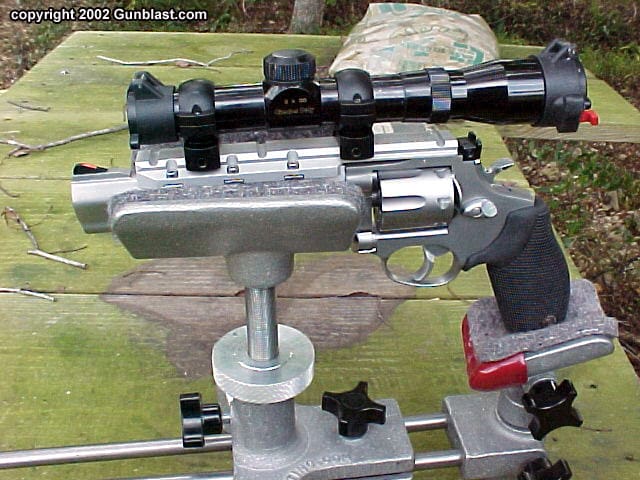
Courtesy Gunblast.com
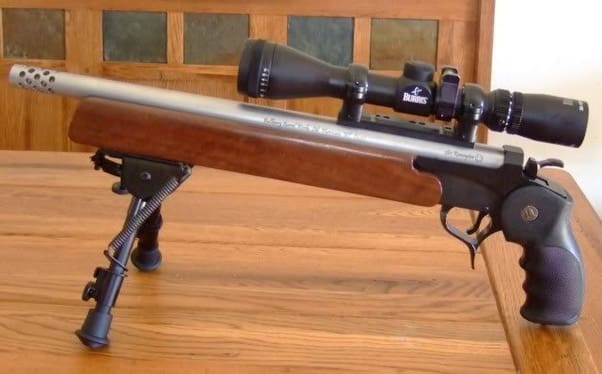
Pistols are capable of great accuracy, and using an optic to take advantage of that is entirely reasonable. Yes, it means the optic will not work properly with the pistol held at arm’s length, but again, there is zero legal requirement that a pistol be held and fired at arm’s length.
No, a pistol stabilizing brace does not prevent one from firing a pistol with one’s eye the correct distance from a rifle optic. Nor does it have to be shouldered to do so. Nor does it mean the user intended for the brace to function as a stock. It can still be handy in many other, perfectly legal ways.
I can fire a pistol one-handed with the optic whatever distance from my eye as I desire, with or without a brace. I can use a brace and fire with my arm bent rather than extended.
This guideline is also as vague and as ambiguous as the rest. Eye relief is measured in inches. If ATF wanted to be objective it would define a numerical minimum.
Peripheral Accessories. Installation of peripheral accessories commonly found on rifles or shotguns that may indicate that the firearm is not designed and intended to be held and fired with one hand. This includes, but is not limited to, the installation of bipods/monopods that improve the accuracy of heavy weapons designed and intended to be fired from the shoulder; or the inclusion of a magazine or drum that accepts so many cartridges that it increases the overall weight of the firearm to a degree that it is impractical to fire the weapon with one hand even with the assistance of a stabilizing brace.
Again here we go with the one-handed, arms extended garbage. No one shoots a pistol this way and no one has to. Just look at the pistols above. And below:
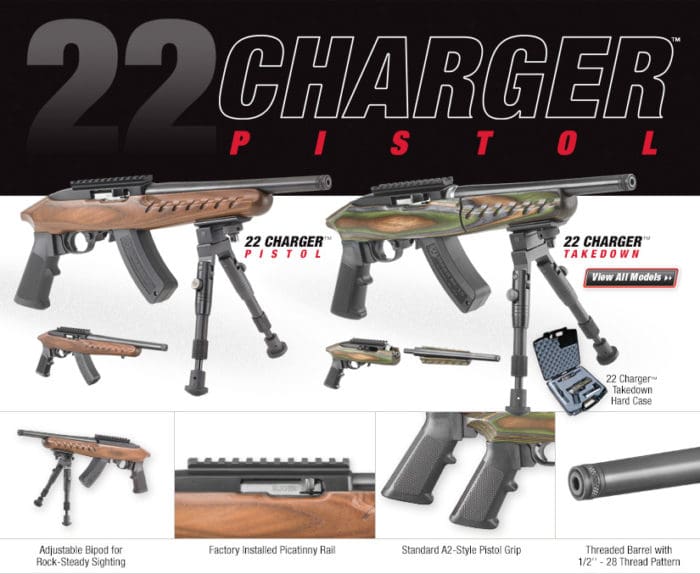
Pistols have shipped from the factory with accessories such as those described by ATF’s “peripheral accessories” guideline for decades without a peep from ATF. It wasn’t a problem for obvious reason. A bipod does not make a pistol a rifle. Shooting a pistol from a rested position does not magically make it a rifle. A heavy pistol is not a rifle.
Also, “objection, your honor! Vague and ambiguous.”
No single factor or combination of factors is necessarily dispositive, and FATD examines each weapon holistically on a case-by-case basis. Because of changes in design or configuration of a weapon or attachment, as well as future changes in technology, this list is not exhaustive and other factors may become relevant to a weapon’s classification.
Perfect. We’ll get right on top of complying with this impossible-to-follow guideline that is constantly changing and applies only on a case-by-case basis.
Apparently ATF simply “knows it when they sees it” when it comes to brace-equipped pistols, and we’ll find out upon our arrest whether or not we’ve violated their opinion du jour.
Perhaps you aren’t a fan of this “Objective Factors for Classifying Weapons with Stabilizing Braces” document? Leave a comment:
…ATF has decided to publish the proposed objective factors in the Federal Register for a brief comment period, given the public interest surrounding these issues. ATF will consider the comments it receives before finalizing this guidance.
Comment, contact the White House, and contact your representatives. More info on how to do all of that is HERE.